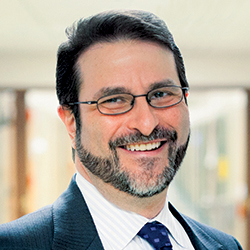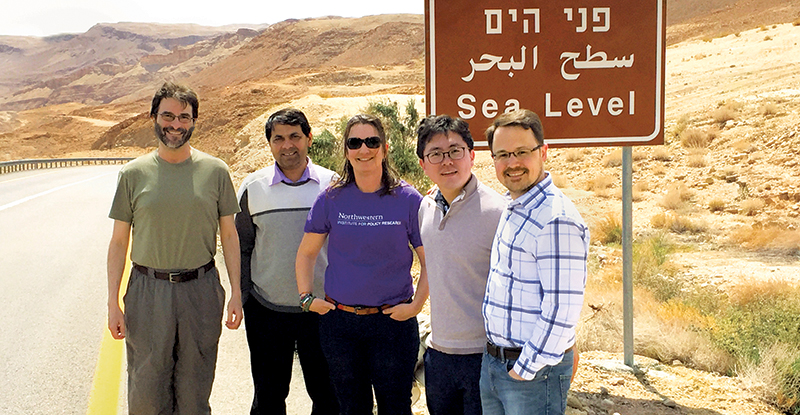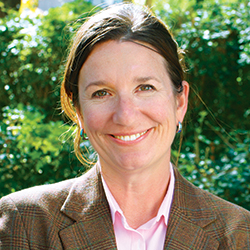A World Without Water
How insecure is the world's water supply? Faculty in the Center for Water Research want to know.
Cape Town made headlines earlier this year when it became the first major city to announce a specific end to its available water supply — a so-called "day zero." On that day, city officials said, water would be cut off for the majority of the 4 million residents in the region.
Though policies that were sprung into action delayed that day until at least 2019, water crises like this have become the new norm: droughts in California and Australia, flooding from storms like Hurricane Florence and Superstorm Sandy, and contaminated water in cities like Flint, Michigan.
As severe crises make the headlines, cities around the world are dealing with the new reality of water insecurity. Centuries-old infrastructure, combined with climate change and population growth in drier areas, has led to

“Every event has been a wake-up call for everyone in that region,” says Aaron Packman, Northwestern Engineering professor of civil and environmental engineering. “But these events are predictable. We know that they are
As director of the Center for Water Research, Packman and his colleagues, along with collaborators around the world, are conducting research to understand the breadth of the problem and using that data to inform the design of next-generation, resilient systems.
Packman is eager to sound the alarm — and to provide tangible solutions. As an environmental engineer with a background in mechanical engineering and extensive post-graduate coursework in microbiology, he takes a multiscale approach to the problem. His own research ranges from understanding the physics of how particles like sand and rock flow in rivers, which has implications for land stability near rivers and deltas, to understanding how biofilms grow in natural and man-made systems, which can help researchers better understand how waterborne diseases are transmitted.
Global Partners, Local Solutions
One institution cannot tackle issues like these alone. That’s why the Center for Water Research has developed partnerships with institutions around the world in countries like Taiwan, Colombia, and England and with global organizations like The Nature Conservancy and the World Wildlife Fund.
"If we do not do this, we will see a major city run out of water in the next 10 years."
Several substantial partnerships are centered in Israel. Because of its dry climate, Israel made early investments in water resource development and technologies for water reuse and desalination. The Center has partnerships with Tel Aviv University and Ben-Gurion University, which have led to student and faculty exchanges as well as joint research projects.
“We can cross-supply information,” Packman says. “We can help them solve water problems in Israel, and they can help us solve practical problems in Chicago.”
Understanding Urban Water Dynamics
For the past several years, Packman has also been working with collaborators across Chicago to understand stormwater dynamics within the region. The city provides an interesting test case: Chicago’s water infrastructure was designed 150 years ago for a much smaller population and for weather events that were the norm then. Though it has a large freshwater supply from the Great Lakes, Chicago is now dealing with changing weather patterns that have given it another chronic problem: too much water in the wrong places, like basements and streets.
For Chicago and a number of other places, the prospects are high for a substantial increase in flooding that will overwhelm the infrastructure that was designed for historical weather conditions, Packman says.
Understanding water dynamics within a city is more challenging than it seems. Because placing sensors in deep underground pipes is difficult, no one knows, for example, how water is distributed beneath the surface when it rains, or how much drinking water is lost from leaky pipes. The American Society of Civil Engineers estimates that aging pipes lose 14 to 18 percent of treated water, which amounts to nearly 6 billion gallons a year.
“It’s really rare, especially for a big city like Chicago, to go in and replace all the water infrastructure,” Packman says. “It’s hard to access and expensive to work on. You have to do a retrofit, which makes it even more difficult. Nobody has been able to start from scratch.”
Turning to Nature for Design
Researchers do know that one way to reduce flooding within cities is with green spaces like parks and nature preserves, which can act as natural sponges in periods of heavy rainfall. So for the past four years, Packman and his colleagues have placed sensors in Indian Boundary Prairies, a nature preserve in Markham, Illinois, to determine how this natural green space affects water dynamics after rainstorms. Sensors measure soil moisture and rain and water levels.
“We want to know what happens when it rains. Where does it go? How much goes into the ground? Where is it stored? How long does it take to come out? What conditions cause flooding?” he says.
Collaborating on this project is Argonne National Laboratory and the University of Chicago’s Array of Things, which uses the networked sensors to collect real-time data on Chicago’s environment, infrastructure, and activity. Packman and collaborators have expanded their sensor network to sites like the Chicago Botanic Garden and Tuley Park in the city’s Chatham neighborhood, which often experiences seasonal flooding.
The goal is to work with current partners, including The Nature Conservancy and the Metropolitan Water Reclamation District of Greater Chicago, to develop tools for analyzing and modeling water storage to understand the relationship between the city’s surfaces — homes, parks, yards — and the sewer system below to prevent future flooding.
The team hopes to collaborate with those involved in green infrastructure projects to design new guidelines and predict performance for green spaces. “The strategies we’re developing here could help solve problems around the world,” Packman says.

Water Scarcity at Home
For Northwestern anthropologists like Sera Young, it is important to couple data on the physical environment with those from the human experience. She and her team study how flooding and other problems with water are understood, and how lack of access to the right amounts of water for health, hygiene, and economic productivity impacts human lives.
Water insecurity — through both scarcity and flooding — is an especially important issue for low- and middle-income countries. Around the world, an estimated 663 million people lack access to safe drinking water, and more than 4 billion people experience severe water scarcity for at least one month a year. While statistics like these capture how much water is available, Young realized there was no systematic way to measure water insecurity at the household level.

“We know how to measure food insecurity,” says Young, an assistant professor of anthropology in Northwestern’s Weinberg College of Arts and Sciences and faculty member within the Center for Water Research. “If we could measure water insecurity
In addition to her work with Packman in Chicago, for the past three years, Young has been leading dozens of colleagues working at 28 sites in 23 countries to develop a cross-culturally valid scale that can measure household-level water insecurity. After interviewing community members and testing questions related to water quality, accessibility, and stability, the group has identified the best survey questions to help them measure perceived water security. The next step is incorporating those questions into large-scale surveys. Then, they can analyze the data to understand how water insecurity affects issues such as child growth, stress and anxiety, economic productivity, and agriculture.
“I want to be able to quantify the impact that the wrong quantity or quality of water has on the world’s most vulnerable people,” Young says. “I think the data from research of this scale will indicate just how far-reaching water insecurity problems have become. Water is used for so much, but it’s not like oil, which can be replaced with other sources of energy. There’s no replacement for water.”
Young is also working with her husband, Julius Lucks, associate professor of chemical and biological engineering, to use his RNA-based technology to develop a simple, inexpensive test that could determine water quality in Chicago or the low-income countries in which Young most often works. Tests for current contaminants, like E. coli, are expensive, and getting results can take more than 24 hours. “I want it to be as easy and as clear as a pregnancy test,” she says.
Preventing a Major City from Running Dry
Young, Packman, and their collaborators recently received funding to develop a framework for assessing and predicting extreme weather impacts in cities. That framework would then be used to develop maps and green infrastructure strategies to reduce vulnerability to extreme weather.
Achieving water security will require both social and technical advances, Packman says. First, cities and regions must recognize that water supplies are vulnerable, and that water systems need to be designed to be resilient to accommodate shifting weather patterns.
Second, cities should incorporate nature-based solutions, like green spaces, and should consider placing modular, smaller water treatment sites at the point of use instead of funneling everything through one centralized plant. That way, water could be treated for its specific need — drinking, agriculture, industry — much more efficiently.
“If we don’t do this, we’ll see a major city run out of water in the next 10 years,” he says. “It could be Cape Town, it could be Phoenix. It’s not as far away as people think.”
